博文
美国麻州现代艺术博物馆(Mass MoCA)参观记(2006年10月14日)
||
美国麻州现代艺术博物馆(Mass MoCA)参观记(2006年10月14日)
黄安年文 2007年3月17日
(按:《美国麻州现代艺术博物馆(Mass MoCA)参观记(2006年10月14日)》一文首发在2006年10月21日
学术交流网美国问题观察栏目,并附有图片 张。)
**************************************************************
在马萨诸塞州东北的小城北亚当斯市有一座面向世界创作前卫闻名全美的现代艺术博物馆(Massachusetts Museum of Contemporary Art)。在北亚当斯市区驱车穿过主街(Main St.)转Marshall St.就到达一座由废弃的大型工厂厂房改装的麻州现代艺术博物馆(87 Marshall Street in North Adams, MA )。在博物馆里参展的有全国知名的现代派画家也有来自中国等世界各地的现代派艺术家。由于这里展厅具有得天独厚的宽阔场地的条件,自然吸引了许多现代派艺术家前来参展,展品的及时更新也不断吸引喜爱现代派艺术的观众,他成了全美规模最大的现代艺术中心。笔者的艺术欣赏能力很低对于现代派艺术尤其陌生,看了这里的展品,使我对于后现代主义艺术的前卫有了较深的印象,欲了解后现代派艺术的新潮流,不能不来麻州现代艺术博物馆看看。
在2006年9月6日—2006年6月29日间。展厅开放的时间是11am - 5pm, 每星期二闭馆。在Columbus Day, Veteran's Day, the day after Thanksgiving, Christmas Eve, and New Year's Eve.均开馆。感恩节、圣诞节、新年原单位日闭馆。参观成人10美元,学生8美元,6-16岁儿童4美元,会员免费。
根据www.massmoca.org提供的资料介绍,展览馆的地址经历了200多年的经济、工业和建筑的发展,建于19世纪占地13英亩的厂址在市区企业产量中占有近1/3的份额。自18世纪晚期到19世纪内战前夕,由19世纪60年代到1942年,从1942年到1985年,企业经历的不同规模的经营发展。Sprague Electric Company在1966年一度雇佣了4137人,1985年关闭,厂房闲置。其后,经过Williams College Museum of Art director Thomas Krens和他的同事的努力, 将废旧厂房改装成大型的现代艺术展览馆,并更名为MASS MoCA,1999年5月30日正式开张。(详见附录一)
MASS MoCA不仅是美国规模最大的现代艺术展览中心,而且 MASS MoCA的功能还是现代艺术的实验室,艺术家可以在这里边创作边展出,这是其他许多展览馆所没有的。展览馆包括10万平方英尺的展览空间,还有足球场长度的单独展厅,展厅的规模和经济实力可以从资料提供的如下数据看出:
10,000-square-foot black box theatre with a clear-span 30-foot ceiling, which can accommodate up to 850 seats.
3,500 square foot lab theater.
Outdoor cinema with a 50-foot-wide movie screen and a 70 mm projector.
Two performance courtyards, one of which spans 22,500 square feet.
Workshop and art fabrication facilities.
5,000 square feet of rehearsal and production support space.
60,000 square feet of office and retail space for commercial tenants in the communications, high tech, and new media industries.
Project Cost
$31.4 million (including $3 million in contributed real estate and $4 million in environmental engineering and feasibility studies)
Project Funding
$22 million construction grant from the Commonwealth of Massachusetts.
$9.4 million in private funds for construction support.
Institutional Funding
$5.6 million in private contributions for programming and start-up. Programming and general operating costs will continue to be supported by admissions revenue and fund-raising initiatives.
走进Mass MoCA,在展厅入口处的长廊里最先映入眼帘的是实验派艺术家Natalie Jeremijenko的杰作倒栽树(Tree Logic)占有足有羽毛球场大的位置,四排高两层楼的支柱,吊着6个串联着的银粉色圆桶,桶内是树根,树木和树叶倒挂生长,长势尚好,颇有生机,显示与自然规律背道也依然可以长得不赖。(详见附录一)
进入楼内大厅参观,里面展品琳琅满目,如果细心观测没有一天时间是看不完的,我们走马观花浏览大概,对于展品有一个总体了解。展品体现了当今世界各种后现代派的艺术品。其中欧洲和中国的作品占有相当的比重,估计与艺术家的联系有关。这里的展品与其说是现代派艺术不如是后现代主义艺术的前卫作品大展现,其中绝大多数作品创作于20世纪80年代以来,20世纪初和二战前的作品几乎没有。S君是Mass MoCA的会员,对这里的情况十分熟悉,她先带我们在展厅外参观,在二楼的楼道墙上展出现代派艺术的墙画(Wall Drawing),作者是一位著名现代艺术家Reckwell的儿子Jarvis Reckwell 2003年年所画,作者的墙画用素描把当代社会生活和自然景观设计在一整块版面上,令人遐想不已。进入展厅所有展品只能观看不可触摸和摄影。我们发现几乎所有实物稍为加工一下就能想象出一幅崭新构思的“作品”。例如在大厅里有一个仿造太空船模型,太空船外有两位太空人在空中行走,象征我们已经步入太空世界,而在太空船下则是极其华丽的时装展。观众可从平面和楼上高处欣赏作品富有不同的感受。在它的对面是众多的现代派艺术画家的个人照及合影照。(见附录四)
在一处有一座高两层的人工堆砌的类似锥体型金属塔山,下面散落着各种各样的同类制品的动物群。(详见附件三)。在大厅一处有硕大无比的蛇骨化石展堪与恐龙化石媲美,在它的后厅里则是被钉在十字架上的耶稣站在一头巨兽上,十字架上有六七个镇兽器串起把十字架吊起,另一侧有两个人吊着以保持平衡,作者把几乎毫不相干的事放在一起,让观众产生联想,其寓意迄今尚未解读。在一个展示室内,是中国古代前后个两个巨大的车轮,直径足有近2米和2.3米,上面是由白纱覆盖的正方形车厢,车顶上有像黄帝塑像的指南针,代表古代中国的四大发明。另外有一个仿制罗盘仪的塑像制品。后现代艺术的展品简直无奇不有,在一个展厅的一角,放着一把再普通不过的旧藤椅,在中国文革前的许多家庭几乎比比皆是,现在成了珍贵的现代艺术品。在一个展厅的一角有一张天罗地网,网上挂满了各种小型汽车飞机和陆地海洋动物的模型,这种模型很难说全是作家自己的作品,而是将各种现成的模型加以整合构思成新的“艺术品”。
有一个展厅里塑造了一个巨象,上面坐着一只老虎。老虎旁边有一只箱子。在这个艺术品旁边是一段欧洲中世纪古城堡的残垣断壁,而这样的断墙残片在国内城乡找来加工几乎不费吹灰之力。还有一个展厅展出了太空船的船仓,船仓里有一些老百姓可以自由进出。在他的旁边是美国造的巨型火箭,火箭上分别有标志俄罗斯、中国、朝鲜、巴基斯坦、哈萨克斯坦、乌克兰、阿富汗、伊拉克、伊朗、古巴、叙利亚等国的分支,这是具有明显意识形态色彩的雕塑品。
展品中华人雕塑家黄永平的作品不少,这位生于中国,来自厦门,生活在法国的现代艺术家,集中国的生活素材和法国的艺术风格,展出了自20世纪80年代以来的不少作品。这些后现代雕塑作品中运用日常生活中的道具,加上文字符号,甚至占卜,尽管看上去实在说不上美感,但是在艺术家看来是一种物质和精神相结合的新艺术。他在一个大工场里,善长把各种报章杂志作为创作原料,放在洗衣桶里搅和变成不同色彩的纸浆,然后堆成纸浆山,然后把纸浆甩在画墙上形成所需要的原创作品,其中最有意思的是其中一个作品是将两本绘画史著作变成纸浆搅和在一起成了艺术品,上面写着:“《中国绘画史》和《现代绘画简史》在洗衣机里搅拌了两分半钟,1987.12.1”。我们在一张DVD短片里看到黄永平在厦门农村地里穿着裤子光着脚,在田埂上专门让农民用烟头将裤子烫穿成一个又一个小洞,这样的艺术作品同样在展览馆中展示出来。看来将生活中的荒诞经历艺术化就可能是一件艺术作品了。
当代世界西方绘画和雕塑艺术主要是以现代派和以反传统、标新立异的后现代派为主流。个性化和主观性日益突出,出现了后印象主义、野兽主义、立体主义、表现主义、未来主义、达达主义、超现实主义、抽象表现主义、风格派等流派, 其中心由西欧转向美国。抽象表现主义、色场绘画、光效应美术在50-60年代流行一时;波普艺术(流行艺术)、新写实主义、偶发艺术与行为艺术盛行于60年代;观念艺术、大地艺术、超写实主义紧随其后。视觉艺术是一种具有较高科技知识创作的图案化美术。80年代以来电脑艺术广泛应用于电影、电视和印刷行业。在雕塑领域出现反传统的四维、五维雕塑、声光艺术、动态雕塑和软雕塑等形式,表现手段日益多样。我们在美国麻州现代艺术博物馆(Mass MoCA)不仅看到了几乎所有这些艺术表现形式,而且还看到了新世纪前卫的艺术表现手段,至于如何评价则是见仁见智的事。
附录:
一,美国麻州现代艺术博物馆(Mass MoCA)的历史演变
Listed in the National Historic Register, the site's 26 buildings form an elaborate system of interlocking courtyards and passageways rich with historical association. Bridges, viaducts, elevated walkways, and red brick facades lend a distinct architectural ambiance to the complex, which throughout its history has been a place for innovation and fabrication using the most advanced knowledge and technology of the day.
Colonial Period (late 1700s ? mid 1800s)
Manufacturing began on and around the site before the Revolutionary War, as its location at the confluence of the two branches of the Hoosic River was ideal for the diverse, small-scale industries of colonial times. By the late 1700s and early 1800s businesses at or near the site included: wholesale shoe manufacturers; a brick yard; a saw mill; cabinet-makers; hat manufacturers; machine shops for the construction of mill machines; marble works; wagon- and sleigh-makers; and an ironworks, which later forged armor plates for the Civil War ship, the Monitor.A fabric swatch produced at Arnold Print Works, c. 1900
Arnold Print Works (1860 - 1942)
In 1860, the print works O. Arnold and Company established itself on a portion of the site and installed the latest equipment for printing cloth. Large government contracts to supply fabric for the Union Army ensured that the business prospered, and during the next four decades Arnold Print Works became the largest employer in North Adams. By the end of the 1890s, 25 of the 26 buildings in the present-day MASS MoCA complex had been constructed, and by 1905, Arnold Print Works employed some 3,200 people as one of the leading producers of printed textiles in the world. Despite decades of success, falling cloth prices and the lingering effects of the great Depression forced Arnold Print Works to close its Marshall Street operation in 1942, consolidating to smaller facilities in neighboring Adams, Massachusetts.
Sprague capacitors
Sprague Electric Company (1942 - 1985)
Later that year, the Sprague Electric Company bought the site. While largely leaving the building exteriors as they were, Sprague made extensive modifications to the interiors to convert the former textile mill into an electronics plant. Sprague physicists, chemists, electrical engineers, and skilled technicians were called upon by the U.S. government during World War II to design and manufacture crucial components of some of its most advanced high-tech weapons systems, including the atomic bomb.
Outfitted with state-of-the-art equipment, Sprague was a major research and development center, conducting studies on the nature of electricity and semi-conducting materials. After the war, Sprague's products were used in the launch systems for Gemini moon missions, and by 1966 Sprague employed 4,137 workers in a community of 18,000, existing almost as a city within a city. From the post-war years to the mid-1980s Sprague produced electrical components for the booming consumer electronics market, but competition from lower-priced components produced abroad led to declining sales and, in 1985, the company closed its operations on Marshall Street.
MASS MoCA (1986 - present)
In 1986, just a year after Sprague's closing, the business and political leaders of North Adams were seeking ways to creatively re-use the vast Sprague complex. Williams College Museum of Art director Thomas Krens, who would later become Director of the Solomon R. Guggenheim Museum, was looking for space to exhibit large works of contemporary art that would not fit in conventional museum galleries. When Mayor John Barrett III suggested the vast Marshall Street complex as a possible exhibition site, the idea of creating a contemporary arts center in North Adams began to take shape.
Joseph C. Thompson, Krens' colleague at the Williams College Museum of Art, was named founding director of MASS MoCA and spearheaded the project's launch. Thompson led the campaign to build political and community support for the proposed institution, which would serve as a platform for the creation and presentation of contemporary art, and develop links to the region's myriad cultural institutions. The Massachusetts legislature announced its support for the project in 1988. Subsequent economic upheaval in Massachusetts threatened the project, but broad-based support from the community and the private sector, which pledged more than $8 million, ensured that it continued to move forward.
The feasibility study for MASS MoCA was led by renowned architects Simeon Bruner of Bruner/ Cott & Associates, Frank Gehry, Robert Venturi, and David Childs of Skidmore, Owings & Merrill. Bruner/Cott was named project architect in 1992 and, in 1995, the Cambridge, Massachusetts-based firm completed the master plan and final designs. They proposed exploiting the unparalleled scale and versatility of the complex's industrial spaces, while establishing a dialogue between the facility's past and the new life it would have as the country's largest center for contemporary visual and performing arts.
As designs for the complex developed, so did the articulation of MASS MoCA's mission. Originally conceived as an institution for the display of contemporary visual arts, MASS MoCA evolved, under Thompson's leadership, into a center that would both present and catalyze the creation of works that chart new creative territory. MASS MoCA celebrated its opening in 1999, marking the site's launch into its third century and the continuation of a long history of innovation and experimentation.
二,麻州现代艺术博物馆(Mass MoCA)的倒栽树(Tree Logic)
In the galleries
Courtyard B
Ongoing
Natalie Jeremijenko: Tree Logic
Natalie Jeremijenko is an artist-experimenter. Her projects and those with an artists' collective called the Bureau of Inverse Technology have consisted of creating devices and situations for the purpose of gathering overlooked facts. These data sets and the means by which they were formed range from the Despondency Index (for which the Bureau installed a motion detector camera on the Bay Bridge in San Francisco, recorded suicides, and graphed the relation of suicides to stock market and other data) to Tree Logic (1999) at MASS MoCA (in which six live trees are inverted and suspended from a truss, displaying the contrived growth responses of the trees over time). In this age of the commodification of information, Jeremijenko has made data her medium.
In Tree Logic, the art of the piece is not found in its condition at any single point in time, but in the change of the trees over time. Trees are dynamic natural systems, and Tree Logic reveals this dynamism. The familiar, almost iconic shape of the tree in nature is the result of gravitropic and phototropic responses: the tree grows away from the earth and towards the sun. When inverted, the six trees in this experiment still grow away from earth and towards the sun - so the natural predisposition of trees might well produce the most unnatural shapes over time, raising questions about what the nature of the natural is.
By framing certain phenomena, such as tree growth or suicides, as a data set, Jeremijenko's work illustrates the ability of scientific presentation to transform information. These phenomena are accessible without the artist's intervention, but her presentation of them allows the viewer to examine and question them in new ways. (In this sense, her inverted trees may be compared to Marcel Duchamp's Fountain, actually an inverted urinal, of 1917.) Our perceptions of trees change when we view them as a collection of growth responses rather than as immutable symbols of the natural world. The public for a work of art, and for Tree Logic in particular, is encouraged to interpret (and debate) motives and outcomes, though the opposite is often true of "real" science, which does not invite public discourse. Through her elaborate framing systems (in this case a metal armature, stainless steel planters, and telephone poles), Jeremijenko revels in exposing the idiosyncratic manipulation intrinsic to combining facts to form "data." Photo: Nick Whitman.
Exhibition made possible by the Sterling & Francine Clark Art Institute.
三,麻州现代艺术博物馆(Mass MoCA)Joseph Beuys的雕塑作品
In the galleries
Building 4 2nd Floor
Ongoing
Joseph Beuys: Lightning with Stag in Its Glare
The work of European sculptor Joseph Beuys is grounded in a tradition of narrative sources that is often absent in American art of the same period. The historic symbolism of Northern Europe, Christianity, and an invocation of the spiritual power of animals and nature course throughout Beuys' diverse activities, from performances and lectures to sculptures and drawings. For Beuys, all these works share a common purpose: "the victory of socialist warmth and self-determination over materialist greed and alienation."
Beuys' dramatic Lightning with Stag in its Glare, (Blitzschlag mit Lichtschein auf Hirsch),1958-85, is the only environment that the artist cast in bronze. An offspring of Beuys' seminal Workshop exhibition at the Martin-Gropius-Bau in Berlin in 1982, this monumental work is encrusted with layers of meaning. At its core, it enacts a dramatic moment in nature: A bolt of lightning (the large, suspended sculpture) strikes the ground, illuminating a stag (cast in highly reflective aluminum). Other animals are present, but are not so well illuminated. There is a goat (a metal cart with a pick resting on it) and worm-like primordial animals (the dark bronze forms scattered on the floor). The final element present, the Boothia Felix, is a metal tripod with a roughly rectangular mass on top of it and a small compass resting on top of that. This element is named for a strip of land in northern Canada that was the first established location of the north magnetic pole.
Beuys invokes the creative energy of nature with the forceful bolt of lightning in this work. In many other works, he incorporated conductive metals to symbolically draw energy from the universe or blocks of lard to represent stored energy. The Stag, illuminated by the lightning, has a special role in Beuys' work and in northern European mythologies. Beuys repeatedly referred to it as a conductor of the soul, a Christ figure, whose shedding and regrowth of antlers symbolized resurrection and the possibility of redemption. According to Beuys, the stag is a guardian for the Primordial Animals, which squirm on the floor without intelligence or direction. These simple creatures, like the dramatic Lightning, were cast from a pile of loam in the center of the Workshop exhibition and have broken metal tools for heads. Finally, the humble Goat recalls an imaginary laborer, constantly and silently working in the background.
The loan of the Beuys sculpture from the Philadelphia Museum of Art was made possible through the support of the Philadelphia Stock Exchange and the Museum Loan Network, a program administered by MIT's Office of the Arts, funded by the John S. and James L. Knight Foundation and The Pew Charitable Trusts. This art card is made possible by a gift from the Robert Lehman Foundation. Support of the visual arts program is provided by The Horace W. Goldsmith Foundation and the Massachusetts Cultural Council, a state agency. Photo: Nick Whitman.
四,麻州现代艺术博物馆(Mass MoCA)现代艺术家群照
Now on view
Building 4 First Floor
Through April 22, 2007
Ahistoric Occasion: Artists Making History
At a time when the very idea of history seems under siege - by governments grown forgetful, by media which assaults already shortened attention spans with ever tighter news cycles, and by historians themselves, who are provocatively re-interpreting long held truths - artists are exploiting the material of history to shape and give new meaning to the present. Ahistoric Occasion spotlights the growing interest in historic reenactment and revision in contemporary art.
Artists include: Paul Chan, Jeremy Deller, Peggy Diggs, Felix Gmelin, Kerry James Marshall, Trevor Paglen, Greta Pratt, Dario Robleto, Nebojsa Seric-Shoba, Allison Smith, and Yinka Shonibare
Ahistoric Occasion: Artists Making History is supported in part by the National Endowment for the Arts; the Massachusetts Cultural Council; the Mohawk Trail Association; the Artists’ Resource Trust, a fund of the Berkshire Taconic Community Foundation; and the LEF Foundation.
See photos of WAMC's live Roundtable broadcast from MASS MoCA to celebrate the opening of Ahistoric Occasion on May 26
Image to left: Nine Lincolns, Hodgenville, Kentucky (2000) by Greta Pratt
五,麻州现代艺术博物馆(Mass MoCA)华人艺术家黄永平的作品
In the Galleries
Second & Third Floor
Through February 25, 2007
House of Oracles: A Huang Yong Ping Retrospective
Born in China and living in France, Huang Yong Ping has a clear view of the rapidly changing lines that demarcate East from West, tradition from modernity. House of Oracles, the first-ever retrospective of his work, opened March 18 at MASS MoCA (the exhibition's only East coast venue). The exhibition muses on history, cultural identity, and globalization through 40 surprising - and sometimes jaw dropping - works ranging from a gladiatorial arena for insects to a 20-ton sand castle to a full-size airplane fuselage. Ping has been shown two previous times at MASS MoCA, first as part of Unnatural Science in 2000 and more recently with Dragon Boat, a major work of sculpture commission and fabricated by MASS MoCA as part of its Yankee Remix exhibition in 2004.
Major support for MASS MoCA's series of programs on contemporary Chinese artists has been provided by the W.L.S. Spencer Foundation. The exhibition is organized by the Walker Art Center, Minneapolis. It is made possible by generous support by Altria. Additional support provided by The Andy Warhol Foundation for the Visual Arts.
Learn more about Huang Yong Ping
写于2006年10月17日
学术交流网(www.annian.net)/美国问题观察/2006年10月21日首发
美国麻州现代艺术博物馆(Mass MoCA附图七幅:
1. 实验派艺术家Natalie Jeremijenko的杰作倒栽树(Tree Logic)
2. 将两本绘画史著作变成纸浆搅和在一起成了艺术品,上面写着:“《中国绘画史》和《现代绘画简史》在洗衣机里搅拌了两分半钟,1987.12.1”
3. 大厅里有一个仿造太空船模型,太空船外有两位太空人在空中行走
4. 一处有一座高两层的人工堆砌的类似锥体型金属塔山,下面散落着各种各样的同类制品的动物群
5. 一处被钉在十字架上的耶稣站在一头巨兽上,十字架上有六七个镇兽器串起把十字架吊起,另一侧有两个人吊着以保持平衡。
6. 在一个展示室内,是中国古代前后个两个巨大的车轮,直径足有近2米和2.3米,上面是由白纱覆盖的正方形车厢,车顶上有像黄帝塑像的指南针
7. 美国麻州现代艺术博物馆的外景
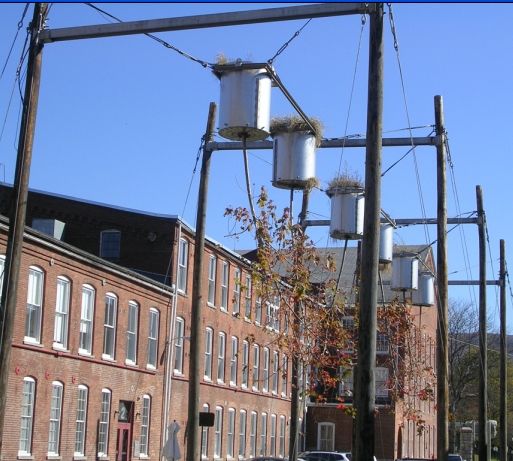
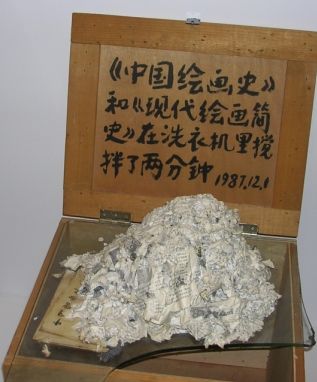
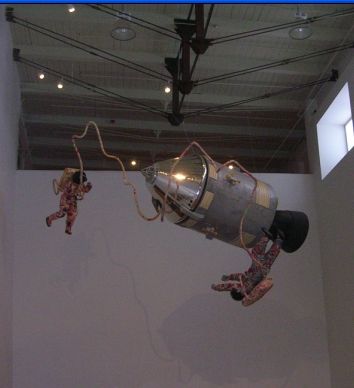
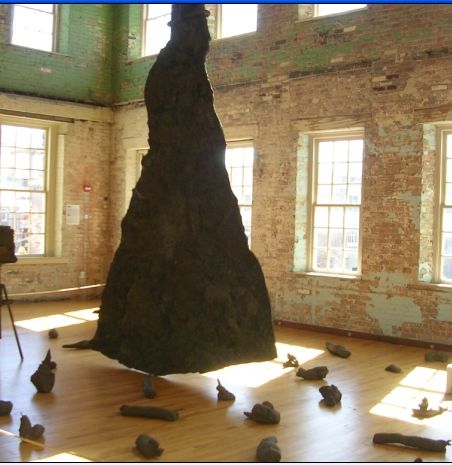
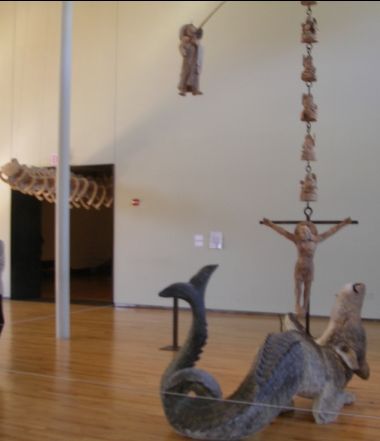
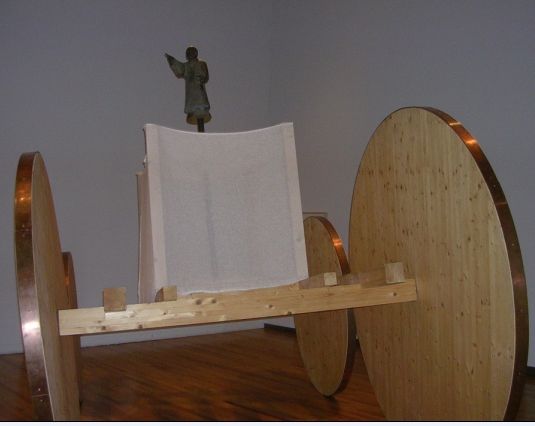

https://blog.sciencenet.cn/blog-415-676.html
上一篇:战后美国的贫困、贫困结构和贫困线
下一篇:夜不闭户·铁栏杆·门卫保安(补充版)